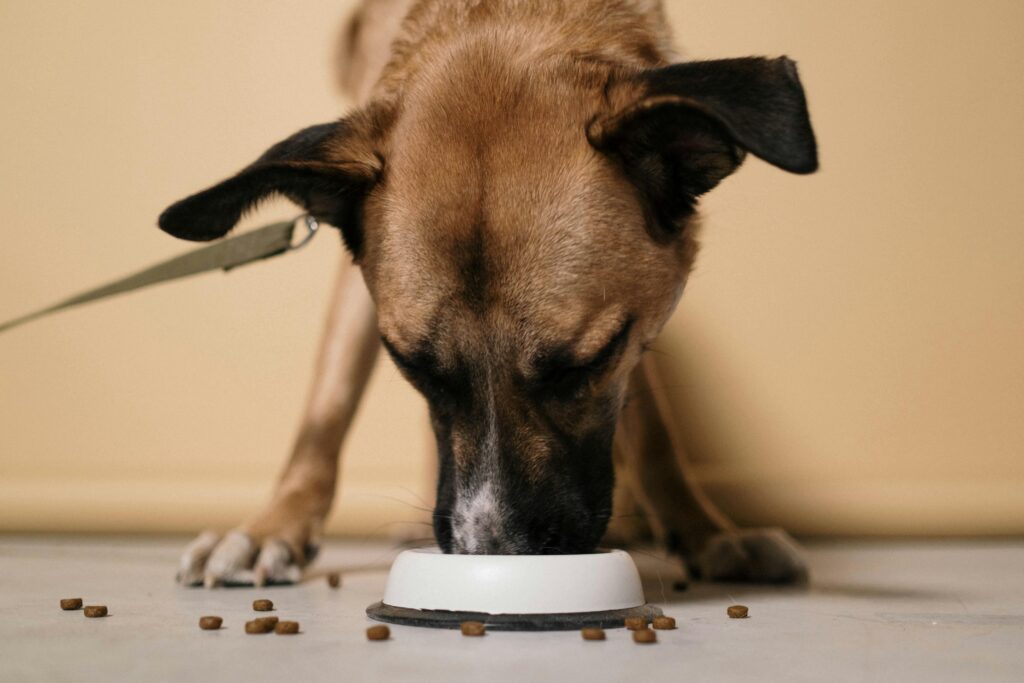Eating too quickly can have negative effects on both humans and animals. For dogs, in particular, eating too fast can lead to a variety of issues such as choking, vomiting, and digestive problems. Dogs are prone to eating quickly due to their natural instinct to consume food as quickly as possible. This behavior stems from their ancestors who had to compete for food in the wild. However, in a domestic setting, this behavior can be problematic and potentially harmful to their health.
Slow Feeding Bowls: A Simple Solution to Slow Down Eating
One simple solution to slow down a dog’s eating is by using a slow feeding bowl. These bowls are designed with various obstacles and ridges that make it more difficult for dogs to gulp down their food quickly. The obstacles force the dog to eat around them, slowing down their eating pace. By using a slow feeding bowl, dogs are encouraged to eat at a more moderate pace, which can have several benefits.
One of the main benefits of using a slow feeding bowl is improved digestion. When dogs eat too quickly, they tend to swallow large amounts of air along with their food. This can lead to bloating and digestive discomfort. By slowing down their eating pace, dogs are less likely to swallow excessive amounts of air, reducing the risk of digestive issues.
Another benefit of using a slow feeding bowl is a reduced risk of choking. When dogs eat too quickly, they may not properly chew their food, leading to larger chunks being swallowed. This increases the risk of choking or blockages in the digestive tract. Slow feeding bowls encourage dogs to take smaller bites and chew their food more thoroughly, reducing the risk of choking incidents.
Portion Control: The Importance of Measuring Your Dog’s Food
Portion control is crucial for maintaining a healthy weight in dogs. Just like humans, dogs can easily overeat if given the opportunity. This can lead to obesity and a variety of health issues. Measuring your dog’s food accurately is essential to ensure they are receiving the appropriate amount of nutrients without overeating.
To measure your dog’s food accurately, it is important to use a measuring cup or scale. Eyeballing the amount of food can lead to inaccuracies and potential overfeeding. It is also important to follow the feeding guidelines provided by your dog’s food manufacturer. These guidelines are typically based on the dog’s weight and activity level, providing a general recommendation for portion sizes.
In addition to measuring their food, it is important to monitor your dog’s body condition and adjust their portion sizes accordingly. If your dog is gaining weight, it may be necessary to reduce their portion sizes slightly. On the other hand, if your dog is losing weight or appears too thin, it may be necessary to increase their portion sizes. Regularly assessing your dog’s body condition and adjusting their portion sizes can help maintain a healthy weight.
Feeding Schedule: Establishing a Routine to Prevent Overeating
Establishing a feeding schedule for your dog can help prevent overeating and promote healthy eating habits. Dogs thrive on routine and having set meal times can help regulate their appetite and prevent them from constantly grazing throughout the day.
When creating a feeding schedule, it is important to consider your dog’s age, activity level, and specific dietary needs. Puppies, for example, may require more frequent meals compared to adult dogs. Active dogs may benefit from smaller, more frequent meals to sustain their energy levels throughout the day.
It is also important to establish a consistent feeding routine by feeding your dog at the same times each day. This helps regulate their metabolism and prevents them from becoming overly hungry or overeating due to irregular feeding times.
Treats and Snacks: Moderation is Key
Treats and snacks can be a great way to reward and bond with your dog. However, it is important to give them in moderation to prevent overeating and weight gain. Treats should only make up a small portion of your dog’s daily caloric intake.
When choosing treats for your dog, opt for healthy options that are low in calories and made with high-quality ingredients. Avoid treats that are high in fat, sugar, or artificial additives. There are many healthy treat options available on the market, or you can even make your own treats at home using simple ingredients like lean meats or fruits and vegetables.
It is also important to consider the size of the treats you are giving your dog. Smaller treats can be more easily incorporated into their daily caloric intake without causing excessive weight gain. If you are using larger treats, consider breaking them into smaller pieces to stretch them out and reduce the overall calorie intake.
Training Your Dog: Teaching Them to Eat Slowly
Training your dog to eat slowly can be beneficial for their digestion and overall health. One effective method is to use a “wait” or “stay” command before allowing your dog to approach their food bowl. This teaches them patience and self-control, preventing them from rushing to eat their food.
Another training technique is to hand-feed your dog small portions of their food. This allows you to control the pace at which they eat and encourages them to chew their food thoroughly. Gradually increase the amount of food you hand-feed them over time until they are able to eat their entire meal at a slower pace.
Consistency is key when training your dog to eat slowly. It may take time for them to adjust to the new routine, but with patience and persistence, they will eventually learn to eat at a more moderate pace.
Interactive Feeding Toys: Keeping Your Dog Busy While Eating
Interactive feeding toys can be a great way to keep your dog mentally stimulated while slowing down their eating. These toys are designed to dispense small amounts of food at a time, requiring the dog to work for their meal. This not only slows down their eating pace but also provides mental stimulation and entertainment.
There are various types of interactive feeding toys available, such as puzzle feeders or treat-dispensing toys. These toys can be filled with your dog’s regular kibble or treats, and they have to figure out how to manipulate the toy to access the food. This engages their problem-solving skills and keeps them occupied for longer periods of time.
Using interactive feeding toys can also help prevent boredom and reduce the risk of overeating. Dogs who are mentally stimulated are less likely to engage in destructive behaviors or seek out additional food sources out of boredom.
Separating Multiple Dogs: Avoiding Competition and Rushing
If you have multiple dogs in your household, it is important to separate them during feeding time to avoid competition and rushing. Dogs may feel the need to eat quickly if they perceive that another dog is going to steal their food. This can lead to overeating and potential digestive issues.
To prevent competition and rushing, feed each dog in a separate room or use barriers such as baby gates or crates to create individual feeding spaces. This allows each dog to eat at their own pace without feeling threatened by other dogs.
It is also important to monitor each dog’s eating habits to ensure they are not stealing food from one another. If one dog finishes their meal quickly and tries to approach another dog’s bowl, gently redirect them back to their own feeding area.
Medical Concerns: Identifying and Treating Digestive Issues
Eating too quickly can lead to various medical concerns in dogs, such as bloat and gastrointestinal issues. Bloat, also known as gastric dilatation-volvulus (GDV), is a life-threatening condition that occurs when the stomach fills with gas and twists. This can be caused by rapid eating and swallowing of air.
Symptoms of bloat include a distended abdomen, restlessness, excessive drooling, and unproductive attempts to vomit. If you suspect your dog is experiencing bloat, it is important to seek immediate veterinary care as it is a medical emergency.
Other digestive issues that can arise from eating too quickly include vomiting, regurgitation, and diarrhea. If your dog frequently experiences these symptoms after eating, it is important to consult with your veterinarian to determine the underlying cause and develop a treatment plan.
Treatment for digestive issues may include dietary changes, medication, or other interventions depending on the specific condition. In some cases, simply slowing down your dog’s eating pace can help alleviate symptoms and prevent further complications.
Taking Steps to Ensure Your Dog’s Health and Happiness
Taking steps to prevent your dog from eating too quickly is essential for their overall health and happiness. By using slow feeding bowls, practicing portion control, establishing a feeding schedule, giving treats in moderation, training your dog to eat slowly, using interactive feeding toys, separating multiple dogs during feeding time, and monitoring for digestive issues, you can help ensure that your dog maintains a healthy weight and avoids potential health problems.
Remember that each dog is unique, and what works for one may not work for another. It may take some trial and error to find the best strategies that work for you and your dog. By implementing these tips and strategies consistently, you can help promote healthy eating habits and improve your dog’s overall well-being.



